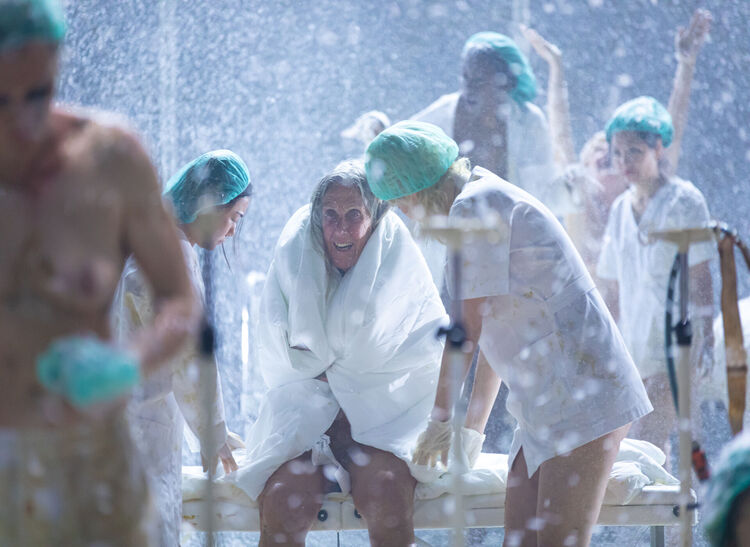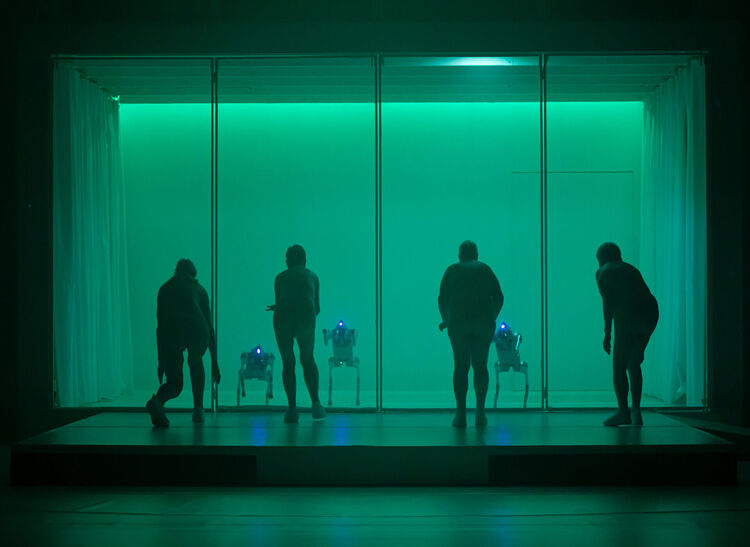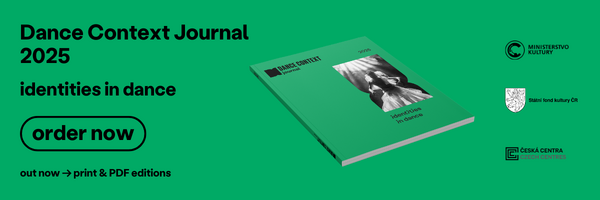The performance begins gently and, much like Ophelia’s Got Talent (2022), opens with a surprisingly composed moment. In a foggy Volksbühne, where only two side screens are visible (perhaps projecting smoke, later supporting the dramaturgy), the performers — women of all ages, some in their seventies and eighties — enter dressed, performing a slow dance, somewhat ballroom in style. Soon, they disrobe, and the atmosphere shifts into an orgy, perhaps dramaturgically excessive, interrupted by an intense emotional moment where they express their desire to stay together, despite everything. The scene closes with the projection of an apocalyptic sun: a pale, hypnotic vortex that captures and freezes the audience gaze.
A Year Without Summer — Is Magic
While the title might evoke the meteorological unpredictability of a Berlin summer — capable of shifting from blazing sun to autumnal rains in hours — the real reference is to the year 1816: the “year without a summer,” marked by the eruption of the Tambora volcano in Indonesia. That cold, anomalous summer devastated crops and caused global famines. It was in this context that Mary Shelley wrote Frankenstein during her legendary “literary vacation” by Lake Geneva. And, as in the novel, this piece also explores “created,” manipulated, and transformed bodies — ghosts and post-humanity.
Medical iconography is central: performers in lab coats re-enter the stage through an inflatable version of Courbet’s L’Origine du Monde (1866). Doctors and nurses seem more like servants of eternity than caretakers. Archetypes from medical history appear: Freud — a cocaine user ridiculed for sexist clichés — and a grotesque Mengele who discards a Nazi flag as if it were trash. A raw and powerful gesture, unmasking historical horror without rhetoric.
Holzinger’s trademarks are all present: nudity, fluids, excrement — but here they feel less provocative, less gratuitous, with a more coherent poetic-political vision. There are feathers, musical numbers, performative medicine. Irony blends with an aesthetic of pain. Cameras take us inside the body, while robot dogs, initially enclosed in a glass case, become sweet puppies caring for the performers: a dystopian yet tender world.
“Ultimate Face Lifting”
There is a birth scene of surgical body horror that is truly painful (whilst also making you laugh), set to the chant “Breathe in / Breathe out” (echoing The Handmaid’s Tale’s handmaid chorus), as a fake embryo is extracted from Holzinger’s own thigh — “a musical is born!” A visceral gesture aligned with the carnal theatricality of her previous works, kicking starting the surreal musical. Another performer undergoes an extreme face-lift onstage (“Ultimate Face Lifting,” as the side screens read): piercings and biostatic hooks stretch her facial skin, transforming her body into a sacred icon, an aesthetic and raw crucifixion.

The theme of aging emerges with power and irony: in a nursing home, jets of fake faeces explode. A visceral rebellion against our obsession with youth, a gesture that uses a cruel vitality to push for the dignity of decay. Here, aging is an act of freedom.
At the same time, a powerful autobiographical element arises: Holzinger’s harsh fall during a performance is recounted, alongside the testimony of octogenarian ballet dancer Beatrice Cordua (who passed away in July 2025), a longtime collaborator, who shares her illness and warmly greets the audience.
Who Wants to Live Forever?
The finale is heartbreaking: they sing Queen’s Who Wants to Live Forever. A skater slowly circles an ice rink as snow falls; the side screens display the words “No End.” Everything cools down. No true conclusion, just an echo hinting at eternity.
Like Frankenstein, A Year Without Summer seeks the spark that gives life — and finds it in bodies, wounds, tired laughter, and the warmth of final applause. Between theatre-performance, medical cabaret, and industrial musical, Holzinger tackles death, solidarity, transformation, and the will to resist.

In 2025, it is hard not to see in this show a reflection of the world around us: a world overwhelmed by climate crises, ongoing wars, political instability, and a growing distrust in the future. A reality bearing the marks of an apocalyptic nightmare, where technology redraws human limits and survival becomes ritual. Into this chaos, Holzinger and collaborators make use of everything at their disposal to tackle such complex issues: surgical practices evoke Frankenstein but pose more urgent questions — about transhumanism, bioengineering, and the manipulation of human boundaries. Yet, there is energy, vitality, resistance. A grounded work, no metaphysics. The concept arrives, but only afterward.
There is little dance here, at least in its technical sense. What dominates are scenic actions, theatrical gesture, and above all, a direction that both ironically — and not — embraces the language of musical theatre — yes, the musical born from Holzinger’s own thigh — sometimes bordering on a musical film. A word of warning: the Holzinger pieces I have seen have always been characterised by a range of media — dance, voice, video, piercing, etc. — but here it is the rhythm that unites them, representing a significant difference. And here lies an unexpected strength: this strange form of musical, with its hybrid nature, manages to “lightly” communicate what otherwise would be too dense. Dialogues, songs, and choreographic fragments intertwine in a lively, accessible experience that knows how to be pop without ever falling into banality. The music is overwhelming: partly live, it supports every scenic action. Musical references are numerous and precise, and at times, even we in the audience feel transported — accomplices to a scene that wants not only to be watched but lived.
The dramaturgy of A Year Without Summer — and kudos to the dramaturgical team for weaving complex themes into a fierce rhythm — intertwines feminist reflections, ethics, and existential inquiries in a radical representation of the body. Holzinger rewrites the post-human stage with new stylistic awareness and renewed sobriety: less clutter, more measure. Fewer scenic objects, more intensity. Whilst the presence of robot dogs remains a high-cost element, anything superfluous is cut out, leaving ‘only’ trampolines, glass cases, a small ice rink, and a giant torso. And real, living, vulnerable bodies. Her recurring elements — pole dance, stunts, live video — now find a clearer balance. “Less is more,” seems to be the implication.
The portrayal of aging and defecation becomes a declaration of the dignity of transience. The real, imperfect, mortal bodyis celebrated with poetic force. The climate apocalypse is linked to the biomedical manipulation of the human body,almost reaching the perversion of nature itself.
And as the real body — aged, dirty, imperfect — is reclaimed as a space of poetry and dissent, dystopia transforms into ritual: collective, emotional, fierce. A show that overwhelms you, makes you laugh, shiver, and cry. It lingers like a summer that never was, but left its mark.
Written from the performance of 8 June 2025,Volksbühne am Rosa-Luxemburg-Platz, Berlin.
A Year Without Summer
By and with: Saioa Alvarez Ruiz, Liane Jil Apel, Andrea Baker, Bear Boy, Sofia Borges, Born In Flamez, Gibrana Cervantes, Renée Copraij, Beatrice “Trixie” Cordua, Sophie Duncan, Luz de Luna Duran, Bláthin Eckhardt, Renée Eigendorff, Fibi Eyewalker, Florentina Holzinger, Sahel van K, Annina Machaz, Achan Malonda, MING, Xana Novais, Netti Nüganen, otay:onii, Constanza Pérez de Lara Bonatti, Sue Shay, Brigitte "Gitti" Ulm, Bärbel Warneke
Live music: Sofia Borges, Born In Flamez, Gibrana Cervantes, Bláthin Eckhardt, MING, otay:onii, Stefan Schneider
Direction, choreography and performance: Florentina Holzinger
Musical direction: Born In Flamez, Stefan Schneider
Composition: Born In Flamez, Josephinex Ashley Hansis, Stefan Schneider
Sound design: Stefan Schneider, Olivia Oyama
Stage design: Nikola Knežević
Costume design: Christiane Hilmer
Lighting design: Kevin Sock
Video design: Zoe Bassi, Max Heesen
Dramaturgy: Fernando Belfiore, Leonie Hahn, Sara Ostertag, Felix Ritter, Michele Rizzo
Robotics: Boiling Head, Zoe Bassi with a thanks to the Roboverse Community
Electrodes: Karsten Schuhl
Assistant director: Xavier Perez, Max Pross
Stage assistance: Christiane Hilmer, Simeon Melchior
Costume assistance: Jasmin Knitter
Assistant dramaturge: Lili Hering
Choreography assistance: Sophie Duncan
Technical direction: Emma Juliard, Stephan Werner, Dario Brinkmann
Stage and rigging: Dörte Wilforth
Stunt coordinator: Ronny Hornig – Gravity Stunts
Coaching: Leon Le Nestour, Elisa Siegmund
Intimacy coaching: Jasko Fide
Intimacy coordination (Casting): Dani Brown and Frida Giulia Franceschini
Sound engineering: Olivia Oyama
Sound assistance: Fjóla Gautadóttir
Production neon lobster: Sarah Parolin, Katharina Wallisch
PR and communication neon lobster: Giulia Messia
Tour management neon lobster: Sarah Parolin with Moira L Sunter Garee
Management and international distribution neon lobster: Katharina Wallisch & Giulia Messia



